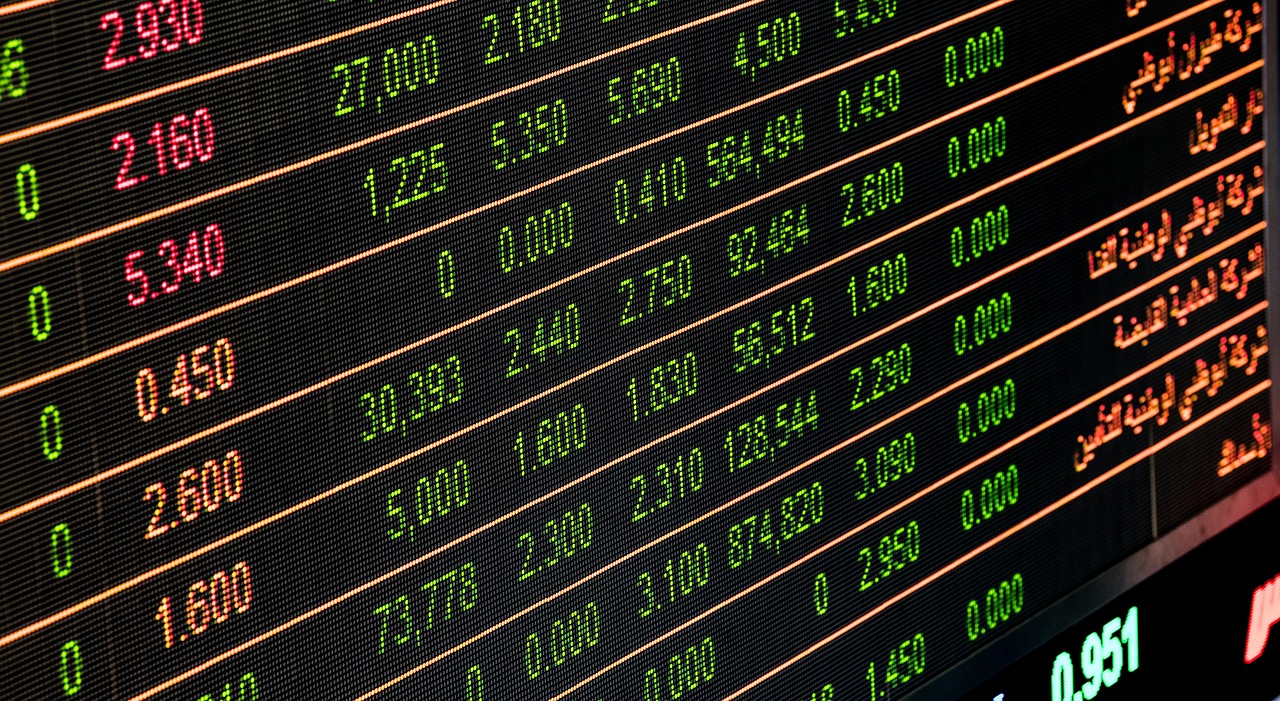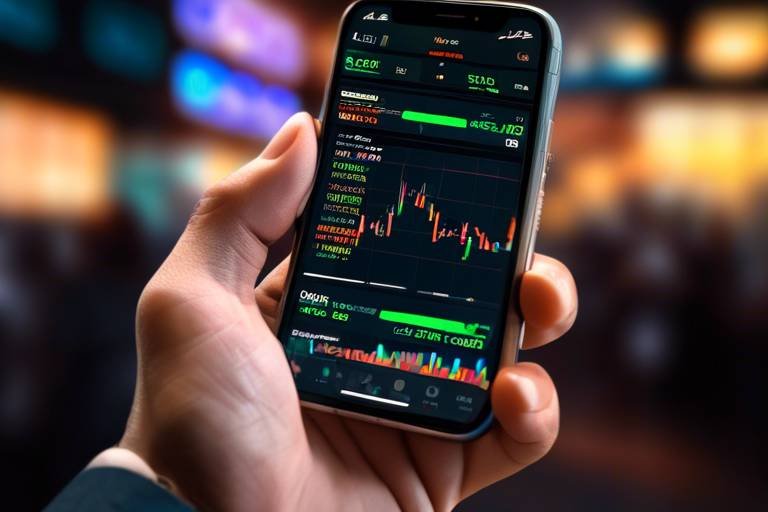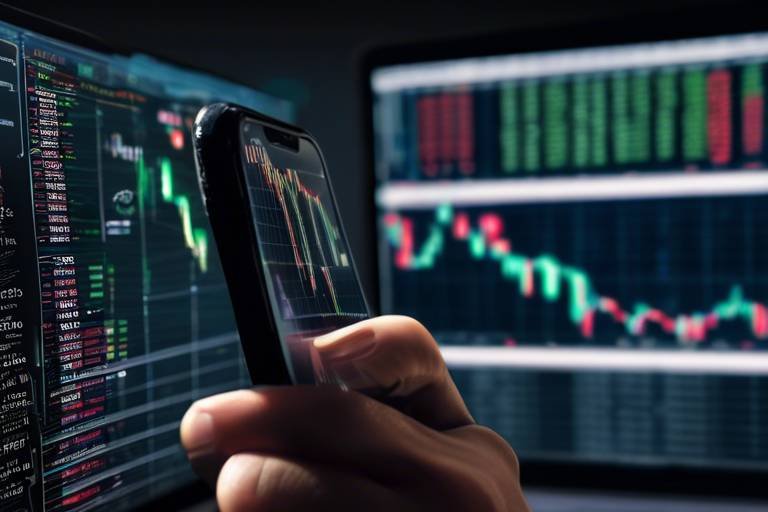The Best Strategies for Crypto Swing Trading
In the fast-paced world of cryptocurrency, where prices can swing wildly in a matter of hours, swing trading has emerged as a popular strategy for traders looking to capitalize on short- to medium-term price movements. But what exactly is swing trading, and how can you make it work for you? In this article, we’ll dive deep into the nuances of swing trading, offering you effective strategies, essential market analysis techniques, and robust risk management practices to enhance your trading success.
First off, let’s clarify what swing trading entails. Unlike day trading, which focuses on executing multiple trades within a single day, swing trading allows you to hold positions for several days or even weeks. This approach can be particularly advantageous in the volatile cryptocurrency market, where price movements can be significant over short periods. By capturing these price swings, traders can potentially achieve substantial returns without the need to monitor the market constantly.
One of the key benefits of swing trading is its flexibility. You don’t need to be glued to your screen all day long; instead, you can analyze the market, make informed decisions, and execute trades at your convenience. This makes swing trading ideal for those who may have day jobs or other commitments but still want to engage in the crypto market. However, it’s essential to have a solid strategy in place to maximize your chances of success.
As we move forward in this article, we’ll explore various strategies that can help you navigate the complexities of swing trading. From understanding market analysis techniques to implementing effective risk management strategies, we’ll cover everything you need to know to become a successful swing trader. So, buckle up and get ready to dive into the exciting world of crypto swing trading!

Understanding Swing Trading
Swing trading is an exciting strategy that allows traders to capitalize on short- to medium-term price movements in various financial markets, particularly in the highly volatile world of cryptocurrencies. Unlike day trading, where positions are often held for just a few hours or even minutes, swing trading usually involves holding assets for several days to weeks. This approach is akin to fishing in a river; you cast your line and wait for the right moment to reel in your catch, rather than constantly casting and reeling in a single spot.
One of the primary benefits of swing trading is its potential for significant profit while requiring less time commitment than day trading. Traders can analyze the market and execute trades without the pressure of being glued to their screens all day long. This flexibility makes swing trading particularly appealing for those who maintain other jobs or responsibilities. Furthermore, swing traders can take advantage of price fluctuations driven by market news, trends, and technical indicators.
In volatile markets like cryptocurrency, swing trading can be especially rewarding. Cryptocurrencies often experience rapid price changes due to factors like regulatory news, technological advancements, and market sentiment. By understanding these movements and utilizing effective strategies, swing traders can position themselves to benefit from both upward and downward trends.
To illustrate the potential of swing trading, consider the following table that compares swing trading with other trading styles:
| Trading Style | Time Commitment | Typical Holding Period | Risk Level |
|---|---|---|---|
| Day Trading | High | Minutes to Hours | High |
| Swing Trading | Moderate | Days to Weeks | Moderate |
| Investing | Low | Months to Years | Low |
As you can see, swing trading strikes a balance between the intense pace of day trading and the long-term commitment of investing. This makes it an attractive option for many traders looking to enhance their portfolios without dedicating every waking hour to the markets.
In conclusion, understanding swing trading is vital for anyone looking to navigate the cryptocurrency landscape successfully. With its unique blend of flexibility, potential for profit, and manageable risk, swing trading offers a compelling opportunity for those willing to learn and adapt. Remember, just like in any fishing expedition, the key is to stay patient, observe the currents, and know when to strike!

Market Analysis Techniques
When it comes to swing trading in the cryptocurrency market, effective market analysis is your secret weapon. It’s like having a treasure map that guides you through the unpredictable waters of crypto trading. You can't just dive in blindly and hope for the best; you need to equip yourself with the right tools and techniques to navigate these volatile waters. Market analysis techniques can be broadly categorized into two primary approaches: technical analysis and fundamental analysis. Each method offers unique insights that can enhance your trading strategy and decision-making process.
Technical analysis is all about the numbers and patterns. It involves examining historical price movements and trading volumes to forecast future price action. Imagine trying to predict the weather based on past patterns—this is essentially what technical analysis does for traders. By using various charts and indicators, traders can identify trends, reversals, and potential breakout points. This approach is particularly useful in the fast-paced world of cryptocurrency, where prices can swing dramatically in a matter of hours.
On the other hand, fundamental analysis digs deeper into the underlying factors that influence a cryptocurrency's value. This includes assessing the technology behind the coin, the team involved, market sentiment, and news events. Think of it like evaluating a company before investing in its stock; you want to know what drives its success or failure. In the crypto world, staying updated on news and developments is crucial, as even a single tweet can send prices soaring or crashing.
Now, let's delve into some of the essential tools that swing traders use for technical analysis. These tools are like your trusty sidekicks, helping you make informed trading decisions:
| Tool | Description |
|---|---|
| Moving Averages | Smooth out price data to identify trends over specific periods. |
| Relative Strength Index (RSI) | Measures the speed and change of price movements, indicating overbought or oversold conditions. |
| Moving Average Convergence Divergence (MACD) | Shows the relationship between two moving averages of a security's price, helping traders identify momentum. |
Each of these tools plays a vital role in helping traders make sense of the market's chaos. For instance, if the RSI indicates that a cryptocurrency is overbought, it might be time to consider taking profits or setting up a short position. Similarly, moving averages can help identify the overall trend, making it easier to decide when to enter or exit a trade.
Recognizing chart patterns is another critical skill for swing traders. These patterns can signal potential price reversals or continuations, providing traders with valuable entry and exit points. Some of the most popular chart patterns include:
- Head and Shoulders: Indicates a reversal trend.
- Triangles: Suggests consolidation before a breakout.
- Flags: Represents a brief pause in a strong trend, often leading to a continuation.
Understanding these patterns can give you an edge in predicting market movements. For instance, spotting a head and shoulders pattern early can help you avoid potential losses or capitalize on a trend reversal.
Indicators and oscillators are powerful tools that provide insights into market momentum and trends. They can help you determine whether the market is bullish or bearish, allowing you to align your trades accordingly. For example, Bollinger Bands can show you how volatile a cryptocurrency is, while the Stochastic Oscillator helps identify potential reversal points by comparing a cryptocurrency's closing price to its price range over a specific period. Using these tools effectively can enhance your trading strategy and improve your chances of success.
In summary, mastering market analysis techniques is crucial for swing trading success. By combining technical and fundamental analysis, you can create a well-rounded approach that helps you navigate the complexities of the cryptocurrency market. Remember, the more informed you are, the better your chances of making profitable trades!

Technical Analysis Tools
When it comes to swing trading in the cryptocurrency market, are your best friends. These tools help you navigate the often turbulent waters of crypto price movements, allowing you to make informed decisions based on data rather than gut feelings. Imagine you’re a captain steering your ship through a storm; without the right instruments, you could easily veer off course. In this section, we’ll explore some of the most essential technical analysis tools that can significantly enhance your swing trading strategy.
First up, we have moving averages. This tool smooths out price data over a specified period, giving you a clearer picture of the trend. For instance, the 50-day moving average can help you identify the overall direction of the market. If the price is above this average, it suggests a bullish trend, while a price below indicates a bearish sentiment. Think of moving averages as a lighthouse guiding you through foggy conditions; they provide clarity when uncertainty reigns.
Next, let’s talk about the Relative Strength Index (RSI). This momentum oscillator measures the speed and change of price movements, typically on a scale from 0 to 100. An RSI above 70 indicates that an asset may be overbought, while below 30 suggests it may be oversold. Traders often use this tool to identify potential reversal points. Just like a roller coaster, the RSI can signal when the ride is about to drop, helping you prepare for the next big move.
Another indispensable tool in your technical analysis arsenal is the Moving Average Convergence Divergence (MACD). This indicator shows the relationship between two moving averages of a security’s price. When the MACD crosses above the signal line, it can indicate a bullish trend, while crossing below may signal a bearish trend. It’s like having a compass that not only points north but also indicates when to change your course based on the wind’s direction.
Chart patterns are another critical aspect of technical analysis. Recognizing patterns such as head and shoulders, triangles, and flags can provide insights into future price movements. For example, a head and shoulders pattern often signifies a reversal from bullish to bearish. Think of these patterns as the market's way of communicating; they tell a story that can help you anticipate what’s coming next.
Finally, let’s not forget about indicators and oscillators. Tools like Bollinger Bands and the Stochastic Oscillator are vital for gauging market momentum and identifying potential overbought or oversold conditions. Bollinger Bands, for instance, consist of a middle band (the moving average) and two outer bands that indicate volatility. When prices touch the upper band, it may signal a reversal, while touching the lower band could indicate a buying opportunity. It’s like having a weather forecast for your trades, helping you prepare for sunny days or impending storms.
In summary, mastering these technical analysis tools can give you a significant edge in the competitive world of crypto swing trading. By understanding how to utilize moving averages, RSI, MACD, chart patterns, and various indicators, you’ll be better equipped to make data-driven decisions that can lead to successful trades. Remember, in the fast-paced crypto market, knowledge is power, and these tools are your key to unlocking that power.
- What is the best technical analysis tool for beginners?
Many beginners find moving averages to be the most user-friendly tool as they provide a clear indication of the trend. - How often should I analyze charts?
It’s advisable to analyze charts regularly, ideally daily or weekly, to stay updated on market trends. - Can I rely solely on technical analysis for trading?
While technical analysis is powerful, combining it with fundamental analysis can provide a more comprehensive trading strategy.

Chart Patterns
Chart patterns are like the secret language of the market, whispering hints about potential price movements. For swing traders, recognizing these patterns is crucial, as they can signal when to enter or exit a trade. Imagine you're a detective, piecing together clues from the charts to forecast the next big move. Some of the most common patterns include the head and shoulders, triangles, and flags, each with its own story to tell about market sentiment and potential price reversals.
The head and shoulders pattern, for instance, is often seen as a harbinger of trend reversals. Picture a mountain with three peaks: the first is a small rise (the left shoulder), followed by a higher peak (the head), and finally another smaller rise (the right shoulder). When this pattern forms, it often indicates that the price is about to shift direction, providing a golden opportunity for swing traders to jump in before the trend changes.
On the other hand, triangles can be either ascending, descending, or symmetrical, and they represent periods of consolidation. Think of it as a coiled spring: the price is getting ready to explode in one direction or the other. Traders watch these patterns closely, as a breakout from a triangle can lead to significant price movements, making it an ideal time to enter a swing trade.
Flags, resembling small rectangles that slope against the prevailing trend, suggest a brief pause before the trend continues. You can think of it as a runner taking a quick breather before sprinting again. When traders spot a flag pattern, they often prepare to capitalize on the continuation of the trend, ensuring they’re in the right place at the right time.
To help you visualize these patterns, here’s a simple table summarizing the key characteristics:
| Pattern | Description | Signal |
|---|---|---|
| Head and Shoulders | Three peaks with the middle peak being the highest. | Potential trend reversal. |
| Triangles | Consolidation pattern that can be ascending, descending, or symmetrical. | Breakout potential in either direction. |
| Flags | Rectangular shape that slopes against the prevailing trend. | Continuation of the trend. |
Understanding these patterns is essential for any swing trader looking to enhance their trading strategy. By identifying and interpreting these chart formations, traders can make more informed decisions, increasing their chances of success in the fast-paced world of cryptocurrency trading. Remember, the key to mastering chart patterns lies in practice and observation—so keep your eyes peeled and your charts ready!
1. What is a chart pattern?
A chart pattern is a graphical representation of price movements that traders use to predict future price behavior. These patterns can indicate potential reversals or continuations in market trends.
2. How do I recognize a head and shoulders pattern?
To recognize a head and shoulders pattern, look for three peaks: two smaller peaks (shoulders) on either side of a larger peak (head). This pattern typically indicates a reversal from bullish to bearish.
3. What does a triangle pattern signify?
A triangle pattern signifies a period of consolidation where the price is narrowing. It can break out in either direction, indicating a potential continuation or reversal of the trend.
4. Why are flags important in swing trading?
Flags are important because they indicate a brief pause in the current trend before it continues. Recognizing this pattern can help traders capitalize on the continuation of the trend.

Indicators and Oscillators
When it comes to swing trading in the cryptocurrency market, indicators and oscillators are your best friends. These tools help traders gauge market momentum and identify potential entry and exit points. Imagine trying to navigate through a dense fog without a compass; that’s how challenging trading can be without these essential instruments. By using indicators and oscillators, you can cut through the uncertainty and make more informed decisions.
One of the most popular indicators is the Bollinger Bands. This tool consists of a middle band (the moving average) and two outer bands that represent price volatility. When the price approaches the upper band, it might be time to consider selling, while touching the lower band could signal a buying opportunity. It’s like having a safety net that alerts you when the price is straying too far from its average.
Another crucial oscillator is the Stochastic Oscillator, which measures the momentum of price movements. It compares a particular closing price of a cryptocurrency to its price range over a specific period. When the Stochastic Oscillator is above 80, it indicates that the asset might be overbought, suggesting a potential price drop. Conversely, a reading below 20 implies an oversold condition, hinting at a possible upward trend. This oscillator acts like a pendulum, swinging back and forth, helping you determine when to jump in or out of a trade.
To further illustrate how these indicators work, consider the following table that summarizes their key attributes:
| Indicator/Oscillator | Purpose | Signal Interpretation |
|---|---|---|
| Bollinger Bands | Measure price volatility | Upper band potential sell; Lower band potential buy |
| Stochastic Oscillator | Gauge momentum | Above 80 overbought; Below 20 oversold |
Using these tools in tandem can significantly enhance your trading strategy. For instance, if the price of a cryptocurrency touches the lower Bollinger Band while the Stochastic Oscillator indicates an oversold condition, it might be a good time to consider entering a long position. This synergy between indicators and oscillators allows you to create a more robust trading approach, increasing your chances of success in the unpredictable world of crypto.
In conclusion, incorporating indicators and oscillators into your swing trading strategy not only helps you make more informed decisions but also enhances your ability to respond to market movements effectively. Remember, these tools are not foolproof, but when used wisely, they can provide valuable insights that guide your trading journey.
- What are indicators and oscillators? Indicators and oscillators are technical analysis tools used to assess market trends and momentum.
- How do Bollinger Bands work? Bollinger Bands consist of a moving average and two outer bands that indicate price volatility, helping traders identify potential buy and sell signals.
- What does the Stochastic Oscillator indicate? The Stochastic Oscillator measures momentum and can signal overbought or oversold conditions based on its readings.
- Can I use indicators and oscillators together? Yes, using them in conjunction can provide a more comprehensive view of market conditions and improve trading decisions.

Fundamental Analysis in Crypto
When diving into the world of cryptocurrency trading, it's easy to get lost in the sea of numbers and charts. However, one of the most important aspects that can significantly influence your trading success is fundamental analysis. Unlike technical analysis, which focuses on price movements and patterns, fundamental analysis digs deeper into the underlying factors that can affect a cryptocurrency's value. It’s akin to understanding the story behind a book rather than just skimming through its pages. So, what exactly should you look for?
In the crypto space, several key elements can provide insights into a coin's potential. Here are the primary factors to consider:
- Technology: The technology behind a cryptocurrency is crucial. Does it solve a real-world problem? Is it scalable? The more innovative and robust the technology, the more likely it is to gain traction.
- Team and Development: The team behind a cryptocurrency can make or break it. A strong development team with a proven track record can instill confidence in investors. Regular updates and improvements are also a good sign of an active project.
- Market Sentiment: The crypto market is heavily influenced by news and social media. Keeping an eye on community sentiment can provide hints about potential price movements. Positive news can send prices soaring, while negative news can have the opposite effect.
- Regulatory Environment: Regulations can significantly impact cryptocurrencies. Understanding the legal landscape in different countries can help you gauge the potential risks and rewards.
- Partnerships and Collaborations: Strategic partnerships can enhance a project's credibility and reach. If a cryptocurrency has notable partnerships, it might be worth considering.
By evaluating these factors, traders can make more informed decisions. For instance, if you hear about a cryptocurrency that has just secured a major partnership or is about to launch a groundbreaking technology, it might be time to consider adding it to your portfolio. Conversely, if there’s news of regulatory crackdowns, it might be wise to reassess your investments.
In addition to these elements, it's also essential to stay updated with the latest news and trends in the crypto space. Websites, forums, and social media platforms can be excellent sources of information. Engaging with the community can provide valuable insights and help you gauge the overall sentiment in the market.
Finally, remember that fundamental analysis is not a one-time task; it requires continuous monitoring and adjustment. The crypto landscape is ever-evolving, and staying informed can give you a competitive edge. So, as you refine your trading strategies, don’t overlook the power of fundamental analysis. It can be the difference between a successful trade and a missed opportunity.
Q: What is fundamental analysis in cryptocurrency?
A: Fundamental analysis in cryptocurrency involves evaluating the underlying factors that affect a cryptocurrency's value, such as its technology, team, market sentiment, regulatory environment, and partnerships.
Q: How can I stay updated on cryptocurrency news?
A: You can stay updated by following reputable crypto news websites, joining online forums, and engaging with the community on social media platforms.
Q: Why is fundamental analysis important for trading?
A: Fundamental analysis helps traders make informed decisions based on the intrinsic value of a cryptocurrency, rather than solely relying on price movements.

Risk Management Strategies
In the exhilarating world of swing trading, where the waves of cryptocurrency prices can rise and fall in the blink of an eye, risk management becomes your lifebuoy. Imagine sailing through stormy seas without a life jacket; that’s what trading without risk management feels like. It’s not just about making profits; it’s about protecting your capital from unforeseen market swings. A solid risk management strategy allows you to navigate the choppy waters of the crypto market with confidence, minimizing losses while maximizing potential gains.
One of the fundamental principles of risk management is to never risk more than you can afford to lose. This notion serves as the bedrock for any successful trading strategy. As a rule of thumb, many seasoned traders suggest risking no more than 1-2% of your total capital on a single trade. This way, even a series of losses won't wipe out your entire account. Think of it as diversifying your investments in a way that each trade is a small piece of your overall financial puzzle.
To implement effective risk management, you’ll need to familiarize yourself with several key techniques. Among these, the use of stop-loss orders is paramount. A stop-loss order is like a safety net that automatically sells your asset when it reaches a certain price, helping to limit your losses. Setting these orders requires a keen understanding of market volatility. For instance, if a cryptocurrency is known for its wild price swings, you might want to set your stop-loss a bit wider to avoid being prematurely knocked out of a trade.
Another essential aspect of risk management is position sizing. This technique involves determining how much of your capital to allocate to each trade based on your overall risk tolerance. The formula for position sizing can be simplified into the following steps:
| Step | Description |
|---|---|
| 1 | Determine your account balance. |
| 2 | Decide the percentage of your capital to risk on a trade. |
| 3 | Calculate the dollar amount you are willing to risk. |
| 4 | Divide the risk amount by the difference between your entry point and stop-loss level to find the number of units to trade. |
By employing these strategies, you can cultivate a disciplined approach to trading that helps you weather the inevitable storms of the crypto market. Regularly reviewing and adjusting your risk management strategies is equally important. Markets evolve, and so should your approach. Reflecting on past trades can provide valuable insights into what works and what doesn’t, allowing you to adapt your strategy accordingly.
In conclusion, effective risk management is not just a safety measure; it’s an integral part of a successful swing trading strategy. By incorporating stop-loss orders, practicing proper position sizing, and maintaining a flexible mindset, you can confidently navigate the thrilling yet unpredictable waters of cryptocurrency trading. Remember, the goal is not only to ride the waves of profit but also to avoid the depths of loss.
- What is the best way to manage risk in swing trading?
The best way to manage risk is to use stop-loss orders and proper position sizing. Always ensure you’re not risking more than you can afford to lose on any single trade.
- How much of my capital should I risk on each trade?
Most experienced traders recommend risking no more than 1-2% of your total trading capital on a single trade to protect your account from significant losses.
- Can I adjust my stop-loss orders after entering a trade?
Yes, you can adjust your stop-loss orders based on market conditions and price movements, but it’s crucial to do so with caution to avoid emotional decision-making.
- What is position sizing?
Position sizing is the process of determining how much of your capital to allocate to a particular trade based on your risk tolerance and the specifics of the trade.

Setting Stop-Loss Orders
In the unpredictable world of cryptocurrency trading, where prices can swing wildly in a matter of minutes, is like having a safety net beneath you. Imagine you’re walking a tightrope; without that net, one misstep could lead to a disastrous fall. Similarly, stop-loss orders can help you limit potential losses and protect your hard-earned capital. But how do you effectively set these levels in such a volatile market?
First, it’s essential to understand the concept of a stop-loss order. Essentially, it’s an instruction to sell a cryptocurrency when it reaches a certain price point. This can be particularly useful in swing trading, where traders aim to capitalize on short- to medium-term price movements. By setting a stop-loss order, you can automate your exit strategy, ensuring that you don’t have to monitor the market constantly.
When determining where to set your stop-loss, consider the following factors:
- Volatility: Cryptocurrencies are known for their price fluctuations. A good practice is to analyze the historical volatility of the asset you’re trading. If an asset typically moves 10% in a day, setting a stop-loss at 5% might not be wise, as it could trigger unnecessarily.
- Support and Resistance Levels: These are critical price points where the asset has historically struggled to move above (resistance) or below (support). Placing your stop-loss just below a support level can provide a buffer against minor fluctuations while still protecting your investment.
- Risk Tolerance: Everyone has a different appetite for risk. Determine how much of your capital you’re willing to lose on a single trade. A common guideline is to risk no more than 1-2% of your total trading capital on any given trade.
To illustrate, let’s consider a hypothetical scenario: you purchase Bitcoin at $40,000, and after analyzing its volatility, you decide that a stop-loss at $38,000 is appropriate. This means that if Bitcoin’s price drops to $38,000, your stop-loss order will trigger, automatically selling your position to prevent further losses. However, if Bitcoin rises to $45,000, you might want to adjust your stop-loss to $43,000, locking in some profits while still allowing for potential gains.
One common mistake traders make is placing their stop-loss orders too close to their entry price. While it’s tempting to protect your investment, doing so can lead to premature sell-offs due to normal market fluctuations. Instead, give your trade some room to breathe! This strategy not only protects your capital but also allows you to ride out minor price corrections.
In summary, setting stop-loss orders is a crucial aspect of successful swing trading. By carefully considering volatility, support and resistance levels, and your personal risk tolerance, you can enhance your trading strategy and safeguard your investments in the ever-changing cryptocurrency landscape.
Q: What is a stop-loss order?
A: A stop-loss order is a type of order that automatically sells a cryptocurrency when it reaches a specified price, helping to limit potential losses.
Q: How do I determine the right stop-loss level?
A: Consider factors such as the asset's volatility, historical support and resistance levels, and your personal risk tolerance when setting your stop-loss level.
Q: Can I adjust my stop-loss order after it's set?
A: Yes, you can adjust your stop-loss order at any time, especially as market conditions change or if your trade moves in your favor.
Q: Is it advisable to use a tight stop-loss?
A: While a tight stop-loss can protect your capital, it may also lead to premature sell-offs due to normal market fluctuations. It's essential to strike a balance based on your trading strategy.

Position Sizing Techniques
When it comes to swing trading, mastering position sizing is crucial for managing risk and maximizing potential returns. Think of position sizing as the foundation of a house; without a solid base, everything else can crumble. It determines how much of your capital you allocate to a single trade, which can significantly impact your overall trading performance. The goal is to find a balance that allows you to take advantage of market opportunities while protecting your hard-earned capital.
One effective method to determine your position size is the percentage risk model. This technique involves deciding what percentage of your total trading capital you are willing to risk on a single trade. For example, if you have $10,000 in your trading account and you decide to risk 2% on a trade, you would only risk $200. This approach helps you maintain a consistent risk level across all trades, which is vital for long-term success.
Another popular method is the fixed dollar amount model. In this model, you choose a specific dollar amount to risk on each trade, regardless of your account size. This could be beneficial for traders who prefer simplicity. For instance, if you decide to risk $100 on every trade, you can easily calculate your position size based on your entry price and stop-loss level. However, be cautious—this method can lead to larger losses if your account size fluctuates significantly.
To illustrate these techniques, consider the following
| Account Size | Percentage Risk (2%) | Fixed Dollar Risk | Position Size (Entry Price $50) |
|---|---|---|---|
| $10,000 | $200 | $100 | 4 shares |
| $5,000 | $100 | $100 | 2 shares |
| $20,000 | $400 | $100 | 8 shares |
As shown in the table, your position size can vary significantly based on your chosen risk model. This flexibility allows you to adapt your strategy according to market conditions and your personal risk tolerance. Remember, the key to successful position sizing is to always keep your overall trading goals in mind.
Another important aspect of position sizing is understanding your stop-loss level. This is the price point at which you will exit a trade to prevent further losses. Your position size should be adjusted based on the distance between your entry point and your stop-loss. The tighter your stop-loss, the more shares you can buy, and vice versa. This relationship reinforces the importance of having a well-thought-out trading plan that includes both entry and exit strategies.
In conclusion, mastering position sizing techniques is essential for any swing trader aiming for success. By employing methods like percentage risk and fixed dollar amounts, you can effectively manage your risk while maximizing your trading potential. Always remember to adjust your position size based on your stop-loss levels and maintain a disciplined approach to your trading strategy. After all, in the fast-paced world of cryptocurrency, being prepared can mean the difference between profit and loss.
- What is the best position sizing technique for beginners? Beginners may find the percentage risk model easier to implement, as it promotes consistency and helps manage risk effectively.
- How often should I adjust my position sizes? You should review your position sizes regularly, especially after significant changes in your account balance or market volatility.
- Can position sizing help prevent large losses? Yes, by carefully managing how much you invest in each trade, you can significantly reduce the risk of large losses.

Developing a Trading Plan
Creating a successful trading plan is akin to crafting a roadmap for a journey—without it, you might find yourself lost in the unpredictable landscape of the cryptocurrency market. A well-defined trading plan outlines your strategies, goals, and risk management techniques, ensuring that you stay focused and disciplined. Think of your trading plan as your personal guide, steering you clear of emotional decisions that can lead to costly mistakes. So, how do you develop a robust trading plan? Let's break it down.
First and foremost, you need to define your goals. Are you looking to make quick profits or are you in it for the long haul? Setting clear, achievable goals will help you determine your trading style and the strategies you need to employ. For instance, if your goal is to achieve a specific percentage return on your investment over a month, your plan should include the steps necessary to reach that target.
Next, it’s crucial to establish your entry and exit points. These are the price levels at which you will buy or sell your assets, and they should be based on thorough analysis. For example, you might decide to enter a trade when a cryptocurrency breaks above a certain resistance level, and exit when it hits a predetermined profit target or a stop-loss level. This systematic approach takes the guesswork out of trading and allows you to act swiftly when the market presents opportunities.
Moreover, incorporating risk management strategies into your plan is essential for protecting your capital. You should determine how much of your total capital you are willing to risk on a single trade. A common rule of thumb is to risk no more than 1-2% of your capital on any given trade. This way, even if a few trades go against you, your overall portfolio remains intact. The use of stop-loss orders is also vital; they can automatically close your position at a certain price point to prevent further losses.
To illustrate, here’s a simple table to help you visualize how to allocate your capital based on your risk tolerance:
| Account Size | Risk per Trade (1%) | Risk per Trade (2%) |
|---|---|---|
| $1,000 | $10 | $20 |
| $5,000 | $50 | $100 |
| $10,000 | $100 | $200 |
After establishing your entry and exit points, along with your risk management strategies, it’s time to review and adjust your plan regularly. The cryptocurrency market is incredibly dynamic; what works today might not work tomorrow. By regularly reviewing your trading performance and adjusting your strategies as necessary, you can stay ahead of the curve. Ask yourself: Are my strategies yielding the desired results? Are there new trends or technologies I should consider? This reflection is key to evolving as a trader.
In conclusion, developing a trading plan is not just a one-time task; it’s an ongoing process that requires attention and adaptation. By defining your goals, setting clear entry and exit points, implementing risk management strategies, and regularly reviewing your plan, you can navigate the volatile waters of cryptocurrency trading with confidence and clarity.
- What is the most important part of a trading plan? The most critical aspect is to have clear entry and exit points, as well as risk management strategies to protect your capital.
- How often should I review my trading plan? It’s advisable to review your trading plan regularly, at least once a month, to ensure it remains effective and aligned with market conditions.
- Can I trade without a plan? While technically possible, trading without a plan is highly risky and often leads to emotional decision-making and losses.

Defining Entry and Exit Points
When it comes to swing trading, defining entry and exit points is like setting the coordinates for a treasure hunt. Without these coordinates, you might wander aimlessly, missing out on potential gains or, worse, falling into traps that lead to losses. So, how do we pinpoint these crucial moments? Well, it all starts with a solid understanding of market conditions and analysis techniques.
Your entry point is the price at which you decide to buy a cryptocurrency, and it should be based on careful analysis. This could involve identifying a support level where the price tends to bounce back or a breakout point where the price surpasses a resistance level. For instance, if Bitcoin is consistently bouncing off $30,000, that could be your entry point. But wait! Just because it looks good doesn’t mean you should dive in headfirst. You need to confirm your analysis with additional indicators, such as the Relative Strength Index (RSI) or Moving Averages.
Once you’ve entered a trade, the next step is to determine your exit point. This is where you decide to sell your asset, ideally locking in profits or cutting losses. A common strategy is to set your exit point based on a predetermined profit target or a trailing stop-loss. A profit target could be set at a specific percentage gain, like 10% above your entry price. On the other hand, a trailing stop-loss allows you to ride the wave of profits while protecting yourself from sudden downturns. For example, if you enter at $30,000 and set a trailing stop-loss at 5%, your exit point will adjust as the price rises, ensuring you don’t lose your hard-earned gains.
To illustrate this further, let's consider a simple table that outlines an example of entry and exit points:
| Trade Action | Price | Reasoning |
|---|---|---|
| Entry | $30,000 | Bouncing off support level |
| Exit | $33,000 | 10% profit target |
Now, let’s not forget the importance of flexibility. The crypto market is notorious for its volatility. What worked yesterday might not work today. Therefore, it’s essential to regularly review your entry and exit strategies. Always be ready to adapt to new information or market conditions. If news breaks that significantly affects a particular cryptocurrency, your initial entry and exit points might need to be reevaluated.
In conclusion, defining your entry and exit points is not just a one-time task; it’s an ongoing process that requires attention and adjustment. By combining technical analysis with a clear strategy, you can significantly improve your chances of success in the thrilling world of swing trading. Remember, the goal is to have a plan, stick to it, but also be willing to pivot when necessary. After all, in trading, as in life, flexibility can often be your greatest asset.
- What is the best time frame for swing trading?
The best time frame often depends on your personal trading style, but many swing traders look at daily or weekly charts to make their decisions.
- How much capital do I need to start swing trading?
While there’s no set amount, starting with at least a few hundred dollars can provide you with enough flexibility to manage risks effectively.
- Can I swing trade with cryptocurrencies?
Absolutely! Swing trading is a popular strategy in the cryptocurrency market due to its volatility and potential for quick gains.

Reviewing and Adjusting Your Plan
In the fast-paced world of cryptocurrency swing trading, having a solid trading plan is just the beginning. It's like setting off on a road trip with a map; you need to be prepared to adjust your route as you encounter detours and roadblocks. Regularly reviewing and adjusting your trading plan is crucial for staying aligned with your goals and adapting to the ever-changing market conditions. Think of it as tuning your vehicle for optimal performance—without regular check-ups, you might find yourself stranded on the side of the road.
Start by scheduling periodic reviews of your trading performance. This could be weekly, bi-weekly, or monthly, depending on your trading frequency. During these reviews, ask yourself key questions: Are you meeting your trading goals? Are your entry and exit points still relevant? Have market conditions changed in a way that impacts your strategy? Reflecting on these questions not only keeps your plan relevant but also helps you identify patterns in your trading behavior.
When you notice that your strategy isn't yielding the results you expected, it’s time to adjust. This doesn’t mean you should overhaul your entire plan; rather, focus on specific areas that need improvement. For instance, if you find that your stop-loss orders are too tight, causing you to exit trades prematurely, consider widening them. Alternatively, if you’re consistently missing out on profitable trades, you might need to rethink your entry criteria. Adjustments should be data-driven, based on your trading history and market analysis.
Moreover, it’s beneficial to keep a trading journal. Documenting your trades, including your thought process behind each decision, can provide invaluable insights during your reviews. This journal acts as a mirror, reflecting your trading habits, emotional responses, and the effectiveness of your strategies. Over time, you’ll be able to spot trends that reveal what works and what doesn’t, allowing you to fine-tune your approach for greater success.
Lastly, don’t forget to stay informed about the broader market landscape. New developments, regulatory changes, or technological advancements can significantly impact the cryptocurrency market. By incorporating this external information into your reviews, you can ensure that your trading plan remains robust and responsive to the world around you. Remember, the key to successful swing trading lies not just in having a plan, but in being willing to adapt and evolve as the market does.
- What is swing trading?
Swing trading is a trading strategy that focuses on capturing short- to medium-term gains in a stock or cryptocurrency by holding positions for several days to weeks. - How often should I review my trading plan?
It is recommended to review your trading plan at least once a month, or more frequently if you are actively trading. - What should I include in my trading journal?
Your trading journal should include details about each trade, such as entry and exit points, the reasoning behind your decisions, and your emotional state during the trade. - How do I know when to adjust my trading strategy?
If you notice consistent losses or if market conditions change significantly, it may be time to reevaluate and adjust your trading strategy.
Frequently Asked Questions
- What is swing trading in cryptocurrency?
Swing trading is a strategy that focuses on capturing short- to medium-term gains in the cryptocurrency market. It involves holding onto assets for several days to weeks to take advantage of price fluctuations, rather than day trading or long-term investing.
- How do I perform market analysis for swing trading?
Market analysis for swing trading can be performed using both technical and fundamental analysis. Technical analysis involves studying price charts and using indicators like moving averages and RSI, while fundamental analysis evaluates news, technology, and overall market sentiment affecting cryptocurrencies.
- What are some essential technical analysis tools?
Some essential technical analysis tools include moving averages, Relative Strength Index (RSI), and Moving Average Convergence Divergence (MACD). These tools help traders identify trends and potential reversal points in the market.
- What are chart patterns, and why are they important?
Chart patterns are formations created by the price movements of an asset on a chart. They are important because they can signal potential price reversals or continuations, helping traders make informed decisions about when to enter or exit trades.
- How do I manage risk in swing trading?
Risk management in swing trading can be achieved through techniques like setting stop-loss orders and determining proper position sizing. These strategies help limit potential losses and protect your trading capital.
- What is a stop-loss order?
A stop-loss order is a predetermined price level at which a trader will exit a losing trade to prevent further losses. It acts as a safety net, allowing traders to limit their losses in volatile markets.
- Why is position sizing important?
Position sizing is crucial because it determines how much capital to allocate to each trade based on your overall portfolio and risk tolerance. Proper position sizing helps manage risk and ensures that no single trade can significantly impact your capital.
- How do I create a trading plan?
To create a trading plan, define your trading goals, risk tolerance, and strategies for entering and exiting trades. It's essential to tailor the plan to your unique circumstances and regularly review it to adapt to changing market conditions.
- What should I consider when setting entry and exit points?
When setting entry and exit points, consider technical indicators, chart patterns, and overall market trends. Establishing clear points helps in executing trades effectively and minimizes emotional decision-making.
- How often should I review my trading plan?
You should review your trading plan regularly, ideally after each trading session or weekly. This practice allows you to reflect on your trades, assess what worked or didn’t, and make necessary adjustments to improve your strategy.



















